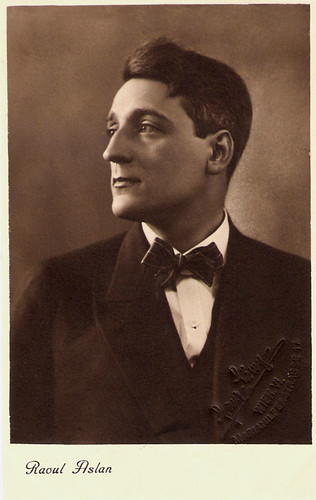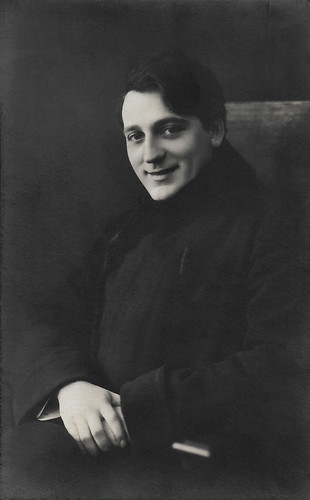
Austrian postcard by Magasin Metropole, Wien. Photo: Franz Xaver Setzer, Wien.

Austrian postcard. Photo: Franz Lowy, Wien (Vienna).
A contract at the Parnassus of the art of acting
Raoul Aslan (Armenian: Ռաուլ Ասլան) was born Tigran Aslanyan (Armenian: Տիգրան Ասլանյան) in 1886 in Saloniki, Ottoman Empire (now in Greece). He came from a formerly wealthy family with Armenian ancestors, as the etymology of the name shows. His father was the son of a rich tobacco planter of Armenian origin, and his mother came from an Italian family that had moved to Egypt.
Raoul's mother, Corinne Paladini, was an orphan girl living in Constantinople when she met Charles Aslan at seventeen. His younger brother was actor Didier Aslan. Raoul's mother tongue was French, as was customary among the upper middle classes of the Ottoman Empire at the time. Aslan was brought up by a Viennese governess, Fräulein Birn, who also taught him German and encouraged his penchant for acting at an early age. He moved to Vienna with his mother in 1896 to attend school - first the primary schools in Johannesgasse, then from autumn 1897 the Imperial and Royal State Grammar School in Fichtnergasse.
At school, he was already interested in acting. After the second grade, Aslan's mother had to send her son to the Piarist Convent in Horn because of poor school results. But even in Horn his performance did not improve and he attended the 7th and 8th grade again in Fichtnergasse, where he had to repeat the 7th grade and was never able to successfully pass the school-leaving examination.
Raould had an overpowering desire for acting. While still a secondary school student he auditioned with Adolf von Sonnenthal, who recommended him to the Deutsches Schauspielhaus in Hamburg as an unpaid trainee. There Aslan received acting lessons from Franziska Ellmenreich from 1906. In the same year, he appeared in 'Julius Caesar'. In the following years, he learned acting at some smaller theatres until he had his first success in Stuttgart in 1911.
From 1914 he had a love affair with his childhood friend Zeljko Koconda, a Croatian singer. His huge success came in 1917 when he got a contract in Vienna and the role of Gabriel Schilling brought him his breakthrough. During the 1910s, he made his film debut and acted in Austrian silent films such as the fantasy film Das andere Ich/The Other I (Fritz Freisler, 1918) opposite Fritz Kortner and Magda Sonja. Aslan also played numerous roles on stage, including Fernando in Goethe's 'Stella' directed by Max Reinhardt in April 1920. Then, he got a contract at the Burgtheater, the Parnassus of the art of acting, and there he spent the rest of his life. His debut was on 1 September 1920 with 'Orest', and his first major classical role was Hamlet directed by Heine.

Vintage postcard. Raoul Aslan as Hamlet.

Austrian postcard by C. Pietzner, k. u. k. Kammerphotograf, Graz. Raoul Aslan, 1914.
On the Gottbegnadeten list of Joseph Goebbels
During the 1920s Raoul Aslan appeared in such Austrian silent films as Die Venus/The Venus (Hans Homma, 1922) with Magda Sonja and Nora Gregor, and Die Kurtisane von Venedig/The Courtesan of Venice (Friedrich Fehér, 1923) starring Magda Sonja. Nevertheless, he preferred to act at the Burgtheater, where he worked as an actor and director.
Under the direction of Wildgans he played Prospero, Jacques in 'As You Like It' and Malvolio in 'Twelfth Night'. Under the direction of Lothar Müthel, he rounded out his Shakespeare repertoire with the Duke in 'Measure for Measure' and Antonio in 'Merchant of Venice'. In 1926 he was the first to receive the title of "Kammerschauspieler" (formerly "Hofschauspieler").
He mainly played classical heroes and complex characters such as Hamlet, Mephisto, Marquis Posa, and Nathan. He also took on Franz Moor in Schiller's 'Robbers" in 1931. Aslan never had a narrowly defined subject but played everything from tragedy to farce equally ravishingly. Between 1920 and 1944 he played up to twelve different new roles a year. His last role in 1944 was that of Kandaules.
In the cinema, he had supporting parts in the German drama Das Flötenkonzert von Sans-Souci/The Flute Concert of Sanssouci (Gustav Ucicky, 1930) starring Otto Gebühr and the war film Yorck (Gustav Ucicky, 1931) starring Werner Krauss as the Prussian General Ludwig Yorck von Wartenburg. Both films were part of the popular cycle of Prussian films, made at the Babelsberg Studios in Berlin. He also appeared in the Ufa production Der weiße Dämon/The White Demon (Kurt Gerron, 1932) starring Hans Albers, Gerda Maurus and Peter Lorre.
Aslan also acted in the separate French-language version, Stupéfiants/ Narcotics (Kurt Gerron, Roger Le Bon, 1932) with Jean Murat. He played Salieri in the Austrian-German musical Leise flehen meine Lieder/Gently My Songs Entreat (Willi Forst, 1933), a biopic of the composer Franz Schubert played by Hans Jaray. Raoul Aslan continued to make Austrian films such as the drama Spiegel des Lebens/Mirror of Life (Géza von Bolváry, 1938) starring Peter Petersen, Paula Wessely, and Attila Hörbiger.

Vintage postcard, no. 9005. Photo: Franz Lowy, Wien (Vienna).

Austrian postcard by Iris Verlag, Wien, no. 886. Photo: Franz Lowy, Wien (Vienna).
Never camouflaging his homosexuality or his rejection of the National Socialist system
In 1932 Raoul Aslan met the actor Tonio Riedl (1906-1995), 20 years his junior, at the Café Ritter on Mariahilfer Straße. In 1936 Aslan finally separated from Zeljko Koconda. Zeljko only broke away from Aslan after serious conflicts, he began to study medicine and settled down as a doctor. However, he died early. Aslan, always conflicted about him, took care of him until Zeljko's death.
Tonio Riedl left Vienna temporarily to make a career for himself, and after the war began in 1939, he played in front theatres. Raoul Aslan was listed on the Gottbegnadeten list of Joseph Goebbels as an important artist of the Nazi state. Aslan became friends with the Burgtheater director Lothar Müthel, who covered for him. Even though Aslan was a favourite of the Viennese public and an outcry of indignation would have gone through the whole of Vienna if anything had been done against him by the National Socialists, he was always in danger.
It was common knowledge that he was an opponent of the regime - he had turned down a role in the propaganda film Jud Süß - but he also had to strive to protect his companion Tonio. When Riedl went on a Wehrmacht tour to escape military service, they wrote each other coded letters. Even the wife of Vienna's mayor Neubacher warned Aslan in the summer of 1941 of a possible arrest by the Gestapo. He played leading roles at the Burg and wrote almost a thousand pious and longing letters to his "beloved Engerl" in three years. In addition, Aslan unsuccessfully sought a "UK position" for Riedl, i.e. indispensability as an actor from the theatre, as he had held.
After the closure of all theatres in 1944, Aslan was drafted into the Volkssturm and he completed air-raid protection service at the Burgtheater. During the National Socialist era, Aslan did nothing to camouflage his homosexuality or his rejection of the National Socialist system. The latter he apparently only unfolded in personal conversation, because no written records of it exist.
Raoul Aslan, like Gustaf Gründgens, is one of the few known homosexuals who did not get into trouble with the authorities during these years. Aslan once said to Gründgens: "Mr. Gründgens, you're the greatest German actor, I am the greatest German actor. But one thing you should never forget: My family comes from Konstantinopel via Thessaloniki to Vienna. And you, Mr. Gründgens, you are from Düsseldorf." Aslan was also deeply Catholic and attended mass every day when possible.

German postcard by Neue Bromsilber-Convention, Berlin (NBC).

German postcard by Neue Bromsilber-Convention, Berlin (NBC). Caption: Raoul M. Aslan.
Director of the Burgtheater
After the war, On 20 April 1945, Aslan initially took up the position of Burgtheater director without a higher commission - the only one to date. The few remaining Burgtheater actors in Vienna had rallied around the popular actor.
He took over the directorship which was confirmed by the Soviets, also because he had demonstrated "upright anti-fascism" throughout the Nazi period. The Burgtheater was not available because of bomb damage, so after many meetings and dealings with the authorities, Aslan concluded a rental contract with the owner of the Ronacher establishment.
On 30 April 1945, they managed to organise Grillparzer's 'Sappho', the first Burgtheater performance after the end of the war, to which the Soviet Marshal Fyodor Ivanovich Tolbuchin appeared - albeit belatedly. Aslan's partner Tonio Riedl played the leading role of Phaon. Before the performance, Aslan gave a speech in which he referred to the time before March 1938. Aslan remained the director of the Burgtheater till 1948.
In the cinema, he acted in the Austrian drama Mozart/The Life and Loves of Mozart (Karl Hartl, 1955) starring Oskar Werner. That year he also acted in the Austrian historical adventure film Goetz von Berlichingen (Alfred Stöger, 1955) starring Ewald Balser. It was a filmed version of the 1773 play 'Götz von Berlichingen' by Johann Wolfgang von Goethe, shot at the Burgtheater. He also acted in Wilhelm Tell (Alfred Stöger, Josef Gielen, 1956) with Albin Skoda.
Raoul Aslan passed away in 1958 in Seewalchen am Attersee, Austria. He was 71. His last role at the Burgtheater was the voice of the Lord in Adolf Rott's legendary production of Goethe's 'Faust', which was still heard on tape after his death in the 1958/1959 season. From 1934 until his death, Aslan lived together with Tonio Riedl in the attic of the house at Strudlhofgasse 13. In the last years, they shared the flat with the private secretary Hermann Fanslau. After Aslan succumbed to a heart attack, Riedl and Fanslau went on a world tour and stayed together. Raoul Aslan is buried at Grinzinger Friedhof in Vienna in a grave dedicated in his honour. His partner Riedl, whom Aslan had adopted, was buried in the same grave under the name Riedl-Aslan.

German postcard by Verlag Hermann Leiser, Berlin-Wilm. no. 2620.

Vintage postcard.
Sources: Isabella Ackerl (Vereinigung der Alt-Hiertzinger - German), Thomas Staedeli (Cyranos), Wikipedia (German and English) and IMDb.
No comments:
Post a Comment